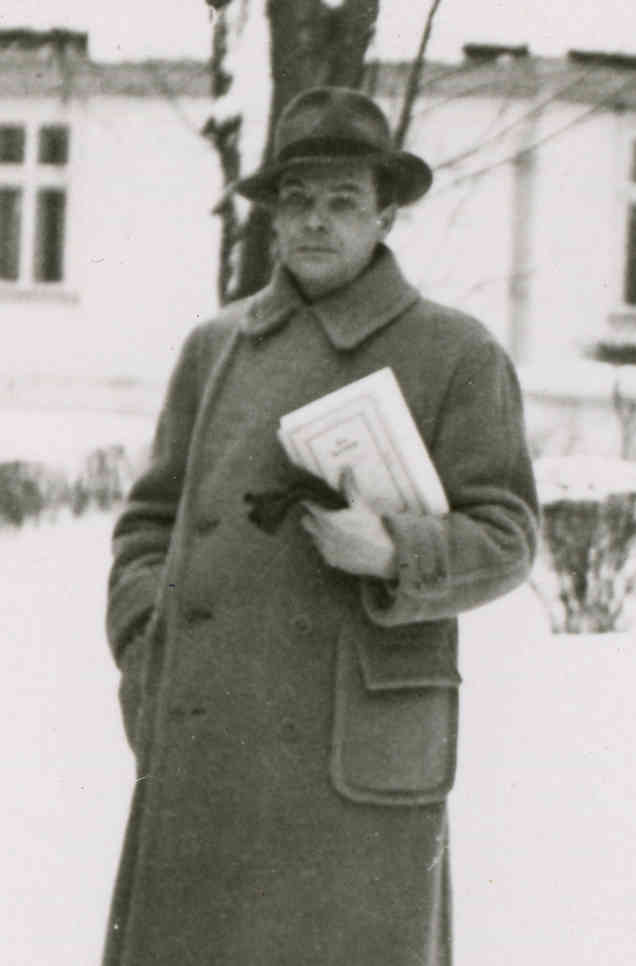
Edzard Schaper
Edzard Schaper (Ernst Edzard Helmuth Schaper, 30. IX 1908 – 29. I 1984) was a German prose writer and commentator who lived in and wrote extensively about Estonia.
Schaper was born at Ostrowo (then in Germany, now on Polish territory), and studied at a Gymnasium and Conservatorium in Hanover. He worked in theatres in various places. After meeting and marrying a German girl from Tallinn, he lived in Estonia from 1930 to 1940 as journalist and writer. After the occupation of Estonia in 1940 he fled to Finland, thereafter moving to Sweden in 1944 and in 1947 to Switzerland, where he lived until his death. He was, among other distinctions, an honorary doctor of the University of Freiburg; he won the gold medal of the Stockholm Estonian National Foundation, the Gottfried Keller award (1967), the Konrad Adenauer prize for literature (1969) and the Grand Cross of Service of the Federal Republic of Germany (1978). He is buried in Glis cemetery.
His first novels appeared in the late twenties: Der letzte Gast (1927) and Die Bekenntnisse des Försters Patrik Doyle (1928). Greater recognition was paid to his novels on Estonian themes in the thirties: Die Insel Tütarsaar (1934), which portrays one man’s inner development, Die sterbende Kirche (1935), which deals with the Russian Orthodox faith in Estonia, and Der Henker (‘The Hangman’, 1940), which is regarded as Schaper’s greatest work, and which appeared in revised form under the name Sie mähten gewappnet die Saaten in 1956. The novel deals with the revolutionary events of 1905 in Estonia, presenting them primarily not through the eyes of the rebels but through those of the representatives of Russian imperial power. Among those leading the punitive expeditions were some Baltic Germans, of whom the most notorious was Karl von Sivers, who may be regarded as the prototype of Count Ovelacker, the main protagonist of the novel. A remorseless punisher becomes an estate owner with the nickname Hangman, who conveys a sense of guilt which is resolved in Christian forgiveness.
While living in Switzerland, Schaper embarked on a productive new period, during which his novels on Estonian themes, among others, appeared: Der Gouverneur oder Der glückselige Schuldner (1954), at the centre of which is the love story of a Swedish officer against the background of the Great Northern War; Der Aufruhr des Gerechten (1963), which deals with the problems of the Estonian Catholic church before the events of 1940; and Epitaph für einen Patrioten (1968), which deals with the situation in Paldiski naval base after the 1939 treaty on the bases.
Estonia played a significant part in Schaper’s literary development; Estonian subject matter has a vital place in his output. Estonia’s fate during and after the Second World War and the situation of the Baltic countries more generally was one of the themes that he dealt with in both fiction and non-fiction. He was one of those who clearly came out in favour of the Baltic countries’ independence, discussing it in essays which appeared in book form as the collection Untergang und Verwandlung (1952). In his works Schaper deals with the intellectual, religious and political turning-points in Europe. The Christian religious background, and the symbolism of a multiple boundary have an important place in his work.
A. K. (Translated by C. M.)
Books in Estonian
Novels
Timukas. Tallinn: Huma, 2002, 703 lk. [2. trükk: 2009.]
Short prose
Täht piiri kohal: jõululegend. Rooma: Maarjamaa, 1964, 60 lk.
Maailma lõpp Hiiumaal. Tallinn: Perioodika (Loomingu Raamatukogu), 1996, 64 lk.
Children’s literature
Legend neljandast kuningast. Tallinn: Kunst, 1995, 79 lk.



